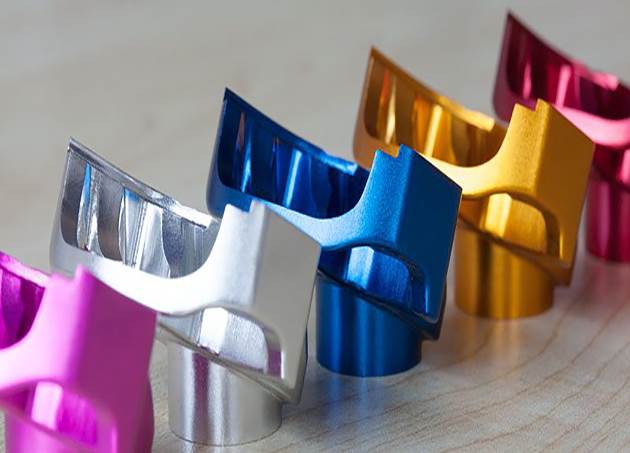What is Type-II Anodizing?
Type II anodizing is a process done by placing the aluminum in a sulfuric bath, which builds up the aluminum oxide on the surface and into the aluminum material, about half and half. The fact that this process builds into the aluminum material also creates an interesting property of the aluminum oxide making it a great electrical insulator. This dielectric property as a result of anodizing will provide aluminum the ability to withstand 800 volts per 0.001” thickness of build-up for type II anodizing. This oxide layer can also be dyed into various colors giving the end product excellent decorative finish options in addition to preventing conductivity and protecting against corrosion.
It is particularly suited for applications where hardness and resistance to abrasion are required. However, where parts are subjected to considerable stress, (such as aircraft parts), the possible presence of the corrosive acid residue is undesirable.

Process of Type-II Anodizing
Anodizing is an electrolytic passivation process that grows the natural oxide layer on aluminum parts for protection from wear and corrosion, as well as for cosmetic effects. It is a conversion coating, similar to Alodine, meaning that the surface of the aluminum recedes dimensionally before the protective oxide layer is built up. After the process is complete, the oxide layer is integral to the aluminum substrate below, which means it won’t chip or flake.
The name anodizing comes from the fact that the treated part forms an anode (positive electrode) in an electrical circuit. During this process, the part to be anodized is hung on a conductive rack and submerged in an electrolytic solution, where a direct current of electricity is introduced. While the acidity of the solution dissolves the oxide layer of the part, the electric current releases oxygen at its surface, which builds up a protective layer of aluminum oxide. By balancing dissolve rate with build-up rate, the oxide layer forms with nanopores, allowing continued growth of the coating beyond what is naturally possible.
The final steps of the anodizing process involve sealing the nanopores. Otherwise, they are the perfect passageways for corrosion initiation! Just before sealing, however, they are sometimes filled with other corrosion inhibitors or colored dyes for cosmetic purposes. After the process is complete, the coating will be 0.0002-0.0012” in thickness, in accordance with the common engineering spec MIL-A-8625 Type II.
Applications
Optical components
Hydraulic valve bodies
Military weapons
Computer and electronic enclosures
Mechanical hardware
Pistons
Easily cleanable
Aluminum rims
Automation / Robotics
Benefits
Several alloys can be finished.
Offers excellent corrosion protection
It can be dyed in a wide variety of colors.
Anodized aluminum prevents further corrosion of aluminum
Harder than the aluminum substrate
Less expensive because of the chemicals used, power, and length of time
Easily cleanable
Anodizing is a safe process and isn’t harmful to human health.
The coating is not conductive-so it serves well for electronic insulation.
Frequently Asked Questions
Which colors can be used for anodizing?
The range of colors could be infinite as different dyes can be made depending on the setup conditions. There are certain popular colors that are always available, custom colors (except white) can be created though per client request.
Is Hard Anodizing & Type II Anodizing same?
Hard anodizing is really Type III though it shares the same mil-spec and acid bath technique. Type III / hard anodize is much thicker and abrasion resistant coating compared to type II.
Can other parts such as Brass or Steel be anodized?
No, the specific part being anodized must only be aluminum as anything else would be damaged by the sulfuric bath.
How thick is the coating for anodizing?
Can you strip old anodized coatings?
Yes; however, it must be noted that stripping the anodic coating will cause some loss in the base material.

